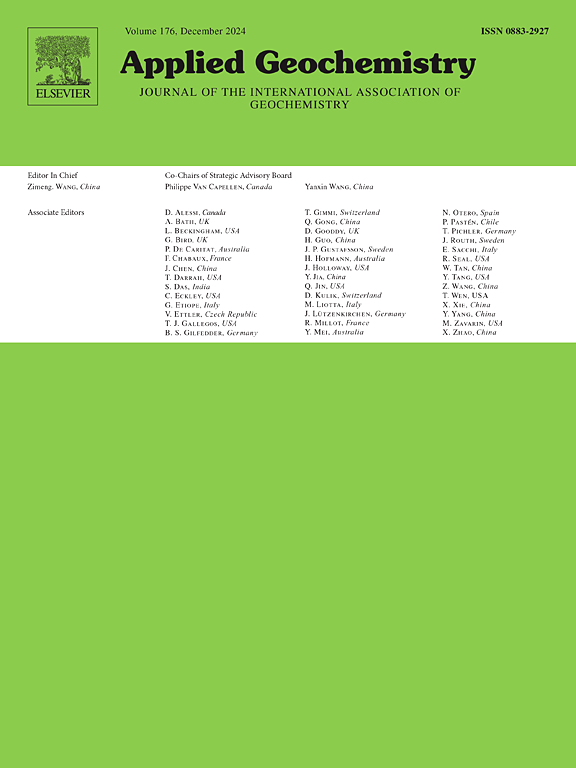Site-specific structure and energetics of uranyl adsorption at hydrated muscovite (001) surfaces probed by classical molecular dynamics simulations
IF 3.1
3区 地球科学
Q1 GEOCHEMISTRY & GEOPHYSICS
引用次数: 0
Abstract
A new series of molecular dynamics (MD) simulations of the Cs+ and UO22+ adsorption on the basal (001) surface of muscovite from relatively low concentration aqueous solutions demonstrates both ions are preferably adsorbed near the centers ditrigonal cavities on this surface. A more realistic random distribution of isomorphic Al/Si substitutions in the muscovite structure allowed us to identify three types of surface adsorption sites somewhat differing in their composition, structure, and local charge distribution. UO22+ ions are preferably adsorbed as outer-sphere surface complexes with one H2O molecule in their hydration shell acting as a bridge to the surface. Adsorption free energies for UO22+ ions at each of the three different adsorption sites were obtained via potential of mean force (PMF) calculations. These adsorption free energy profiles as a function of distance along the direction normal to the surface indicate that UO22+ ions at two the adsorption sites exhibit only stable OS surface complexes with energy minimum around −26 kJ/mol. At the same time at the third adsorption site, that was not observed and studied in earlier simulations, an inner-sphere surface complex is identified with an energy minimum almost twice as deep as the outer-sphere complexes at the two other adsorption sites. Significant agreement of the present results with available experimental data and results of other MD simulations is also demonstrated, while the sources of observed disagreements and inconsistencies are identified and discussed in detail.

求助全文
约1分钟内获得全文
求助全文
来源期刊

Applied Geochemistry
地学-地球化学与地球物理
CiteScore
6.10
自引率
8.80%
发文量
272
审稿时长
65 days
期刊介绍:
Applied Geochemistry is an international journal devoted to publication of original research papers, rapid research communications and selected review papers in geochemistry and urban geochemistry which have some practical application to an aspect of human endeavour, such as the preservation of the environment, health, waste disposal and the search for resources. Papers on applications of inorganic, organic and isotope geochemistry and geochemical processes are therefore welcome provided they meet the main criterion. Spatial and temporal monitoring case studies are only of interest to our international readership if they present new ideas of broad application.
Topics covered include: (1) Environmental geochemistry (including natural and anthropogenic aspects, and protection and remediation strategies); (2) Hydrogeochemistry (surface and groundwater); (3) Medical (urban) geochemistry; (4) The search for energy resources (in particular unconventional oil and gas or emerging metal resources); (5) Energy exploitation (in particular geothermal energy and CCS); (6) Upgrading of energy and mineral resources where there is a direct geochemical application; and (7) Waste disposal, including nuclear waste disposal.
 求助内容:
求助内容: 应助结果提醒方式:
应助结果提醒方式:


